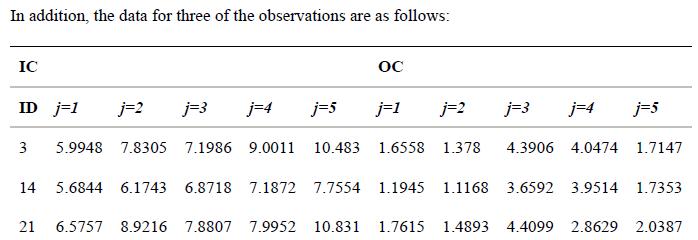Suppose you have estimated a model that includes only the installation and operating cost variables. The results
Question:
Suppose you have estimated a model that includes only the installation and operating cost variables. The results are:


(a) The negative of the coefficient on ocij can be interpreted as the marginal utility of a dollar of annual income. Given this, interpret the ratio of the coefficient on icij over the coefficient on ocij.
(b) Using a spreadsheet, compute the probability of choice for each alternative/person combination.
(c) Using a spreadsheet and the formula derived in exercise 16.2, compute for each person the elasticity of the probability of alternative 1, with respect to the installation cost for each of the five alternatives (i.e. compute one own- and four cross-cost elasticities).
(d) Once again using the negative of the coefficient on ocij as the marginal utility of annual income, use a spreadsheet to compute the one-time WTP for a 15 percent reduction in the installation cost of alternative j=5, for each of the three people (recall that the cost variables are measured in 100s of USD, and adjust accordingly).
Data from exercise 16.2
For the specification in exercise 16.1, derive expressions for the elasticities of the probability of alternative j with respect to a change in Xij and a change in Xik, for k not equal to j.
The following exercises are based on data describing the choice of residential home heating systems in newly constructed homes in California. The dataset home_heating (available on the book’s website) was provided by Prof. Kenneth Train, and it forms the basis for homework assignments in his discrete choice econometrics course at UC-Berkeley. We observe 900 single-family homes that were newly built and have central air conditioning. Five types of home heating systems were considered feasible in these homes:
- central gas heating (j=1)
room gas heating (j=2)
central electrical heating (j=3)
room electrical heating (j=4)
heat pump (j=5). - In addition to an indicator for choice, the dataset includes the following variables:
id – unique identifier for each household ic1, ic2, ic3, ic4, ic5 – installation cost (in 100s of USD) for each of the J=5 alternatives oc1, oc2, oc3, oc4, oc5 – annual operating cost (in 100s of USD) for each of the J=5 alternatives income – annual income for the household (in 1,000s of USD) age – age of household head rooms – number of rooms in the house r1, r2, r3, r4 – dummy variables for the region of the state where the home is located. - Regions include northern coast (r1), southern coast (r2), mountain region (r3), and central valley (r4). The installation and operating cost variables vary over both households and alternatives, while the income, age, region, and room count variables vary only over households.
Step by Step Answer:

A Course In Environmental Economics
ISBN: 9781316866818
1st Edition
Authors: Daniel J Phaneuf, Till Requate





